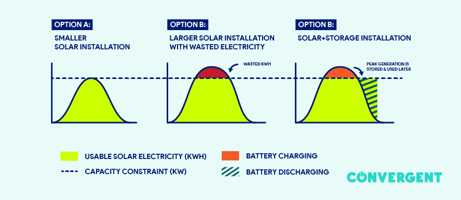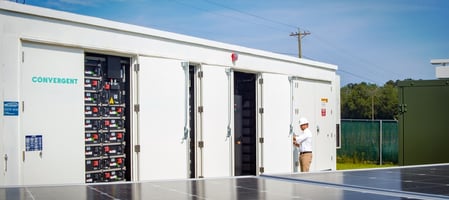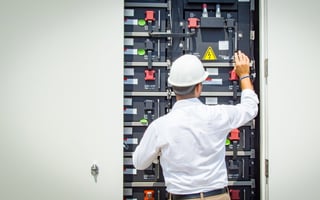Energy Storage Spotlight: Solar-Plus-Storage Provides a Non-Wires Alternative for National Grid

As announced earlier this spring, Convergent Energy and Power (Convergent) partnered with industry-leading utility National Grid to deliver a solar-plus-storage system providing a non-wires alternative (NWA). This system is a breakthrough solution rarely seen elsewhere. This blog highlights key insights into this superlative system and why it is so valuable to National Grid, its utility customers, and the future of energy; it also covers the opportunity to address grid challenges with solar-plus-storage.
Convergent’s Customer: National Grid
National Grid is an electricity, natural gas, and clean energy delivery company with over 20 million customers across New York and New England. As an investor-owned utility (IOU), National Grid juggles many competing priorities to meet the growing power consumption across its service area and doing so in a way that satisfies the cost, energy sustainability, and power reliability requirements of regulators.
The Challenge: Addressing a Projected Capacity Shortfall with Energy Storage
National Grid had an additional needle to thread when energy demand began outstripping capacity at its Pine Grove substation in Cicero, NY. 10-year projections showed Pine Grove vulnerable to distribution system reliability concerns without reliable added capacity (by 2022).
National Grid’s decision to address this potential capacity shortfall before it became an issue for its customers reflects a best-in-class example of strategic planning. To ensure their transformer was not overloaded—which leads to blackouts, brownouts, and interruptions in power supply—National Grid turned to a non-wires alternative (NWA).
An NWA removes or defers the need to construct or upgrade components of a distribution and/or transmission system. While the situation at the Pine Grove substation could have called for building a new substation altogether, National Grid, in accordance with New York State Department of Public Service policies, sought effective NWA solutions. It sought an NWA that would not only remove or defer the need to construct or upgrade components of its distribution or transmission system but would also help increase the amount of renewable energy on the grid and be cost-effective for its customers.
Through a competitive bidding process, Convergent stepped to the front of the line with a trailblazing, multi-use, solar-plus-storage solution. Convergent offered National Grid its solar-plus-storage system as a service, along with the ability to alleviate National Grid’s load and voltage constraints.
The Solution: Best-in-Class Energy Storage Application
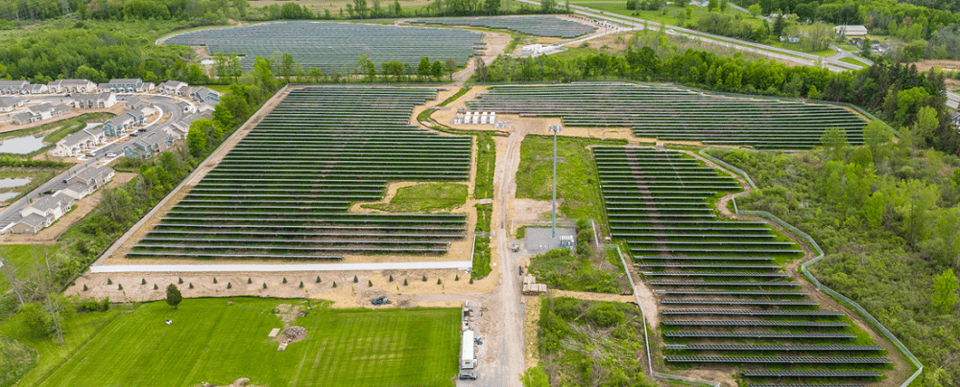
Convergent, which has over a decade of expertise developing energy storage and solar-plus-storage solutions, offered the right solution at the right time: a first-of-its-kind approach optimized for transitioning the grid to a more sustainable, reliable, and resilient future. After working closely with National Grid to crunch the data and analyze the need for a proactive solution, Convergent financed, designed, and constructed a 10 MW/40 MWh of energy storage system connected to 15 MWdc of solar power, one of the first solar-plus-storage solutions ever to provide an NWA.
Why Solar-Plus-Storage
- It is sustainable–100% solar-powered, the systems are reliable, resilient, and emissions-free.
- It is an “always on” energy resource–ready to be dispatched when needed.
- It is affordable–owned and operated by Convergent, the solar-plus-storage system for National Grid is cost-effectively increasing capacity at the Pine Grove substation while also delivering community solar to residents, further reducing costs for the community. This is an example of what the industry refers to as “value-stacking.”
To Convergent’s knowledge, the solution it offered to National Grid is one of the first (if not the first!) examples of a solar-plus-storage system providing an NWA (versus a standalone battery storage system). The resulting solar-plus-storage solution—delivered in time for the 2022 summer season owned and operated by Convergent for National Grid—is now operational and available for dispatch with sub-second response. Using an advanced satellite communications system connected directly to National Grid’s operations center, Convergent has pushed the envelope to make solar-plus-storage a seamless, near real-time asset for the utility, enabling the IOU to control the asset as they see fit— no phone calls or email dispatch requests required.
Brian Gemmell, then National Grid’s Chief Clean Energy Development Officer, said, “National Grid is committed to reducing greenhouse gas emissions by increasing the amount of renewable energy on the grid while improving reliability and affordability for customers. We recently released Clean Energy Vision plan outlines a pathway to achieve a fossil-free future for our energy systems that incorporate renewable sources of energy and storage solutions such as this NWA. Convergent Energy and Power’s expertise in developing and operating energy storage solutions that benefit utilities and communities made them a natural fit for this project.”
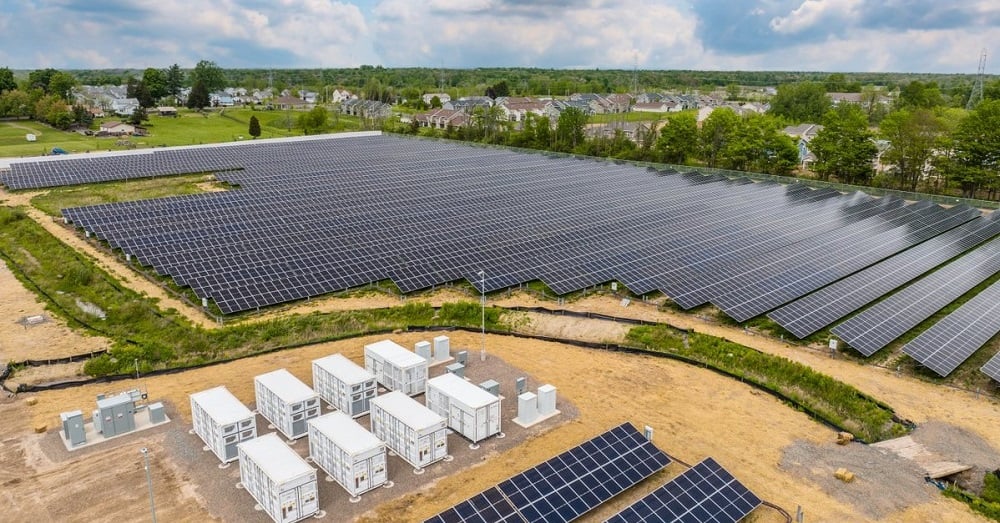
The Outcome
Thanks to this solution, solar power can be tapped into as a clean and affordable source of power during more of the day, during peak or non-peak demand, and regardless of whether the sun is shining. And it came not a moment too soon: the summer of 2022 presented National Grid customers with record-high temperatures that required the company’s infrastructure to work overtime. But the solar-plus-storage solution made that wholly achievable.
Note you can read the full National Grid case study here.
Key Takeaways: The Value Utility-Scale Solar-Plus-Storage
Utilities are adopting battery storage and solar-plus-storage in growing numbers. The combination of solar arrays and utility-scale batteries provides a flexible, proven, multi-use solution to meet the grid’s 21st-century challenges, accelerating the clean energy transition. Third-party-owned solar-plus-storage solutions put utilities in control of always-on clean power resources while providing a reliable partner for the day-to-day operations and maintenance, enabling utilities to keep their focus on what they do best. Key takeaways include:
- National Grid, like other utilities, is seeing the value of battery storage and solar-plus-storage as a “resilience as a service” application
- Third-party owned solar-plus-storage solutions put utilities in control of “always on” clean power while providing a reliable partner for day-to-day operations and maintenance
- Solar-plus-storage provides utilities like National Grid the invaluable one-two punch of a resilient and reliable asset to increase capacity and green power
- Solar-plus-storage solutions reflect the next generation of NWA
- Collaboration and solutions-oriented approaches create great outcomes for utilities, developers, investors, and suppliers
Energy Storage: Key Decisions and Next Steps
As an industry leader in the energy sector, Convergent has over a decade of expertise in delivering industry firsts optimized for transitioning the grid to a more sustainable, reliable, and resilient future. More than ever, we’re eager to continue delivering energy storage and solar-plus-storage solutions for utilities and businesses alike.

If you are looking to find creative modern solutions for resilience as a solution, Convergent’s solar-plus-storage system could be the right approach.
Energy Storage Adds Value Immediately: Start the Conversation Today!
Energy storage is necessary for our power system; it’s the key to not only saving your community money but also creating a more flexible grid. The future of energy storage is now. We’re having more and more conversations with utilities that are looking to deploy a battery storage system to reduce costs, increase sustainability, and improve reliability.
If you’re interested in learning more about how energy storage (with or without solar PV) can benefit your utility, please contact us today for a free, customized evaluation.
